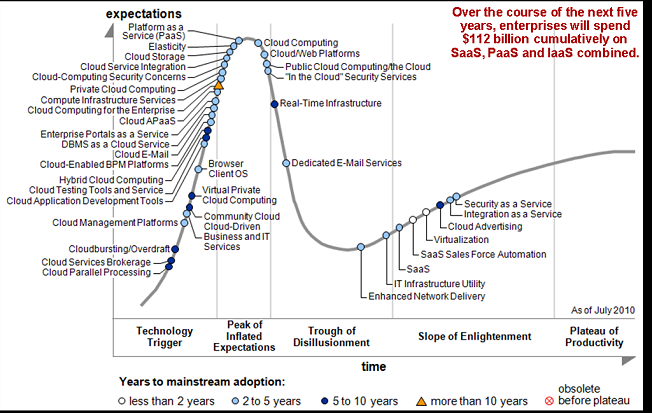In the last year or so Cloud technologies seem to be everywhere, every bank’s technology department is desperately building private clouds, and most vendors are re-badging their services as Cloud products.
Cloud computing is advertised on television & the Underground in London – even my mum knows about the Cloud.
Gartner’s Hype Cycle shows Cloud technologies are currently near the ‘Peak of Inflated Expectations’ and are ready to fall into the ‘Trough of disillusionment’.
Gartner Hype Cycle for Cloud Computing, 2010 (c) Gartner Inc

Cloud computing is and will be a significant part of the future of computing technology – basically because it makes sense to utilise only what you need when you need it – as you do with electricity, water and gas.
Without the hype Cloud will become a utility. Why would anyone want to spend money on hardware, infrastructure, real-estate, support, licences and resources when there are computing utility companies out there ready to supply you with reliable, secure computing power on demand from their extensive, global grid.
We think a couple other references from the supply of utilities and the market place are crossing over to the computing world:
Metering
The location of a electricity meter within your home is a given. It provides both you and the supply company with common reference point the amount of power consumed.
In most IT organisations the usage processing power is more granular, it is generally bought by the server, the processor or maybe a proportion of the machine and charged whether the power is utilised or not. This is changing with the provision of first virtualised and now cloud based services but does metering make sense in this context?
A number of challenges need to be addressed in order for this to work. Your household supply is generally from one provider supplying all the power. The electricity company itself will purchase power from multiple suppliers and sources but you have one retailer.
With Cloud there are multiple vendors potentially both internal and external to your organisation that want to supply you directly with computing resources. It is likely the larger organisations would have more than one supplier for different purposes, pricing or risk mitigation purposes – the hybrid cloud.
There are opportunities here for service companies to provide the metering capability whilst managing the wholesale suppliers of computing – this model could result in better prices for clients as the metering company’s bulk purchasing power should drive the ‘cost per CPU tick’ down.
Smart metering is currently a hot topic in the utilities world and a convergence of computing, electricity & other utilities is likely in the near future.
Virtual Marketplace and Exchanges
Amazon constantly innovates to provide new services and products which has kept it the number one online retailer for years. The success of the ideas varies but the introduction of a virtual marketplace where other vendors can sell using the Amazon site now provides a significant slice of revenue for the company.
Could this be applied to computing power & resources? There is no reason why not – sellers of product could advertise their products and organisations could ‘click and buy’.
As these products are commoditised then the next logical step is the construction of a Cloud Exchange with many buyers and sellers in the market with a constantly changing price depending on demand and supply. A futures market of computing power with derivatives trading on trends and market intelligence would surely follow.
Cloud computing is growing significantly and Forrester expect it to expand from $40B today to $240B by 2020 (differing slightly from the Gartner view) with the significant part of that Software as a Service. We think that Business processes as a Service are the area where a significant advantage can be created from the Cloud and are currently working with our partners to build a strategy to progress this.
It will be interesting to see if and how far organisations will use the cloud for their core revenue generating applications – currently the appetite is very limited due to concerns over security, control & reliability as highlighted in Amazon’s cloud recent outage.
Concerns over hidden costs (such as transition/migration costs, architectural changes & integration aspects) are starting to rise as maturity of the model progresses.
The book is open on how long it is before Cloud becomes so part of the normal world that it ceases to be mentioned – on the ‘Plateau of Productivity’ in Gartner’s words.